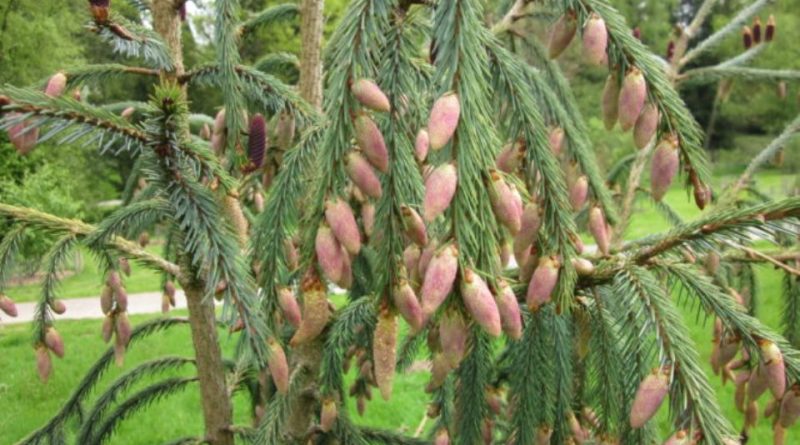Picea farreri
Picea farreri
The Farrer’s spruce (Picea farreri, C.N.Page & Rushforth, 1980) is an arboreal species belonging to the Pinaceae family.
Systematics –
From a systematic point of view it belongs to:
Eukaryota domain,
Kingdom Plantae,
Pinophyta division,
Class Pinopsida,
Pinales Order,
Pinaceae family,
Genus Picea,
P. farreri species.
The term is synonymous:
– Picea brachytyla var. farreri (C.N.Page & Rushforth) Eckenwalder.
Etymology –
The term picea is the Latin name of the wild pine in Virgil and Pliny.
The specific farreri epithet honors the traveler and collector of plants, Reginald John Farrer (1880 – 1920), who was the first to collect the species during an exploration in Burma and introduced its seed to England, where it was planted in various arboretums and private parks.
Geographic Distribution and Habitat –
Picea farreri is an endemic conifer of an area which includes western Yunnan (Nu Jiang valley) and northern Myanmar (Fen-Shui-Ling valley).
Its habitat is that of the open forest where it is found in small pure forest formations, with bamboo and juniper undergrowth. At lower altitudes it sometimes mixes with species of the genus Larix, Tsuga dumosa and Pinus armandii. In Myanmar, it grows in cool, moist limestone mountains with heavy monsoon rains, at altitudes of 2,400 to 2,700 m above sea level.
Description –
Picea farreri is a conifer that grows up to 30-35 m in height, with a single trunk of 60-70 cm in diameter.
The bark is gray or gray-brown, wrinkled and divided into irregular plates.
The crown is largely conical and the branches of the first order are long, slender, horizontal or facing downwards, pendants, those of the second order are always long, slender and pendants; the shoots are slender and drooping, olive-brown, then orange-brown, with prominent grooves, initially with scattered pubescences, then glabrous. The poorly developed pulvini are 0.6-1 mm long, pubescent, orange-brown, arranged at 40°-60° with respect to the axis of the shoot.
The leaves are needle-like, glaucous-green or green above, with two white bands of stomata below, linear, straight or slightly curved, with a convex upper page and a flat lower page, with an acute and slightly prickly tip, 1.8- 2.3cm; they have 5-6 lines of stomata on the underside. The buds are ovoid-conical, slightly resinous and 4-5 mm long; they have obtuse pearls, persistent for years and of a hazel or brown-purple colour.
The male cones are axillary, 1,5-2,5 cm long, of a yellowish colour.
The female cones are ellipsoidal-cylindrical, with an oblique 5 mm long peduncle, first erect and then hanging when ripe, 6-12 cm long and 2,5-4,5 cm broad, with obtuse apex, initially green or green-purple, then dark brown when ripe. The macrosporophylls, 12-22 mm long and 8-15 mm broad, are obovate-oblong, slightly convex, with a smooth, finely striated and wavy, glabrous surface; their bracts are rudimentary, ligulate, 2-3 mm long, entirely hidden. The seeds are brown, oblong-ovoid, with a narrow tip, 4 mm long, with a 13-15 mm winged part, of a glossy orange-brown colour.
Cultivation –
Picea farreri is a conifer that grows at altitudes between 2400 and 2700 m, on calcareous soils. The reference climate is cool and humid, with abundant monsoonal rainfall.
Its cold hardiness limit is between -6.6° and -1.1°C.
It is a species spread over a small area and therefore very susceptible to the erosion of the area also due to deforestation.
Its propagation occurs by seed and the plant is present outside its natural range in rare collections or as an ornamental plant.
Customs and Traditions –
Picea farreri has sometimes been described as a variety of P. brachytyla ((Eckenwalder 2009) but is currently classified as a distinct species.
This interesting species was described in 1980 (Notes Roy. Bot. Gard. Edin., Vol. 39, pp. 129–36).
Its wood is only used locally in construction. Extremely rare in vegetable gardens and botanical gardens, Page and Rushforth discovered the only cultivated specimen in 1979, in Hampshire.
It is a very rare and localized species, with only 2-3 known sub-populations, with a primary range of 20 km². Certain details are not known on the impact caused by deforestation and for this reason it is classified as a vulnerable species in the IUCN Red List, susceptible to future variations.
Method of Preparation –
Picea farreri is an endemic conifer of a small area where it has been used for its timber while no other uses are known.
Guido Bissanti
Sources
– Acta Plantarum – Flora of the Italian Regions.
– Wikipedia, the free encyclopedia.
– GBIF, the Global Biodiversity Information Facility.
– Useful Tropical Plants Database.
– Conti F., Abbate G., Alessandrini A., Blasi C. (ed.), 2005. An annotated checklist of the Italian vascular flora, Palombi Editore.
– Pignatti S., 1982. Flora of Italy, Edagricole, Bologna.
– Treben M., 2000. Health from the Lord’s Pharmacy, Advice and experiences with medicinal herbs, Ennsthaler Editore.
Photo source:
– https://repo.rbge.org.uk/image_server.php?kind=1500&path_base64=L2hlcmJhcml1bV9zcGVjaW1lbl9zY2Fucy9FMDAvNDI5Lzk4Ny81MTE4NjIuanBn
Attention: The pharmaceutical applications and alimurgical uses are indicated for informational purposes only, they do not in any way represent a medical prescription; we therefore decline all responsibility for their use for curative, aesthetic or food purposes.


